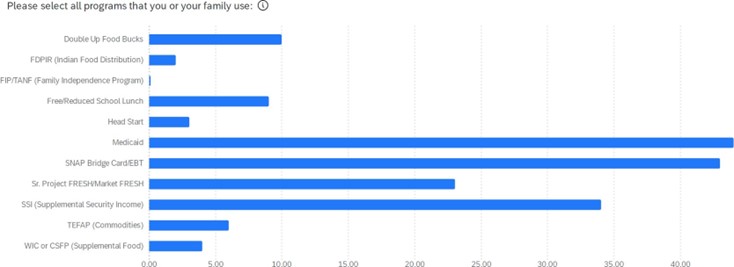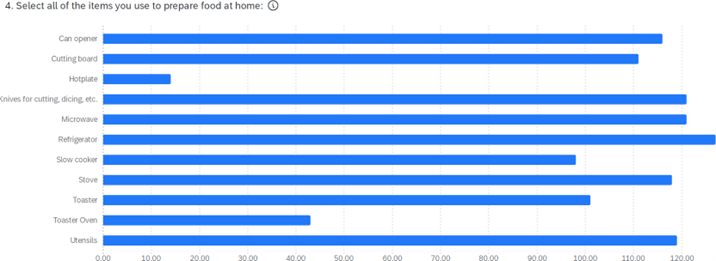
Manistee Food Pantry Client Survey Report
DOWNLOADMarch 14, 2023 - Michigan State University Extension
Michigan State University Extension helps people improve their lives through an educational process that applies knowledge to critical issues, needs and opportunities.
Background
The primary objective of the survey is to understand what barriers pantry guests face in accessing food. Additionally, the survey will be used by the Manistee Food Pantry coalition to understand if clients are receiving the food they want, an adequate amount of food, and how clients want the food presented.
Methods/Demographics
A total of 157 adults completed the food pantry client survey electronically through Qualtrics. The majority of participants were over the age of 60 years, female, non-Hispanic, and white. Federal programs that participants utilize are available below.

Results
- Eighty-seven percent of the participants reported they visit or need the help of a food pantry.
- Most participants took the survey from BACN, Manistee Senior Center- Council on Aging, and Matthew 23:35 at St. Joseph Catholic Church.
- Majority of participants get their food by driving followed by someone else driving them
- Reported problems getting to a place to get food is the price of gas and getting in line
- Majority of participants reporting they would travel 6 to 10 miles to visit a food pantry
- Friday followed by Wednesday were the top two days to visit a food pantry with 8:00am to noon being the best time to visit a pantry.
- Most participants, 77%, are very satisfied or somewhat satisfied with the amount of food and the variety of food they get at the food pantry.
- Foods requested to be added to the pantry distribution include: fresh produce, eggs, canned meat, chicken, milk, jelly, peanut butter, cheese, black beans, walnuts, juice, paper products, ketchup, gluten free foods, butter, kids snacks, cat food, bread, flour and sugar occasionally
- The majority of participants, 99%, would take more fresh fruit and vegetables if the food pantry offered them. They would also prefer them in pre-bagged amounts.
- The majority like to choose their own food and would like it to resemble a grocery store, be a drive thru or be delivered to them.
- Top four nutrition education topics preferred by participants include: healthy food budgeting, healthy snack options, reading nutrition facts and ingredient lists and choosing foods with lower added fats, sugar and sodium. Other topics mentioned included: healthy foods for breakfast, gluten free cooking, diabetic meals, canning, and low carb meal suggestions.
- Other participant feedback included: too much dried beans, rice, lentils, ask what kind of bread participants would like, easier sign in, and having recipe handouts for foods given out.
- The items used to prepare food at home are outlined below.




 Print
Print Email
Email




